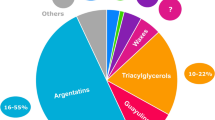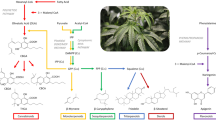Abstract
SEVERAL methods of characterizing cannabis resin have been previously reported. Thus, methods have been developed based on indophenol reaction with 2,6-dichloroquinonechlorimide1, on a test with peroxide and sulphuric acid2, on determining the content of the acid fraction3 as well as on direct ultra-violet spectrophotometry4. It has been shown in the course of this work that the differences in chemical composition shown by various types of cannabis resin may be explained by the stage of development of a phytochemical process by which cannabidiolic acid is gradually converted to cannabidiol, tetrahydrocannabinols and finally to cannabinol. In previous work in this Institute this conversion process was referred to as ‘ripening’ of the resin. Thus, cannabis in which cannabidiolic acid (the initial substance in the conversion of cannabinols) predominated was classified as ‘unripe’. The resin containing mostly physiologically active tetrahydrocannabinols was referred to as ‘ripe’. An ‘intermediate’ type of the drug contains predominantly cannabidiol, while the resin, including mostly cannabinol (the final conversion product), corresponds to the ‘overripe’ cannabis. An alterated type of resin, supposed to contain mostly disintegration products of cannabinols, has also been encountered. The progress of the ripening process in cannabis resin and consequently the formation of a given type was supposed to be affected by climatic, genetic and other ecological factors.
This is a preview of subscription content, access via your institution
Access options
Subscribe to this journal
Receive 51 print issues and online access
$199.00 per year
only $3.90 per issue
Buy this article
- Purchase on Springer Link
- Instant access to full article PDF
Prices may be subject to local taxes which are calculated during checkout
Similar content being viewed by others
References
Grlić, Lj., Acta Pharm. Jug., 11, 129 (1961).
Grlić, Lj., J. Pharm. Pharmacol., 13, 637 (1961).
Grlić, Lj., and Andrec, A., Experientia, 17, 325 (1961).
Grlić, Lj., Farm. Glas. (in the press).
Krejči, Z., Horak, M., and Šantavy, F., Acta Univ. Olomuc., 16, 9 (1958).
Krejči, Z., Horak, M., and Šantavy, F., Pharmazie, 14, 349 (1959).
Schultz, O. E., and Haffner, G., Z. Naturforsch., 14, B, 98 (1959).
Schultz, O. E., and Haffner, G., Arch. Pharm., 293, 1 (1960).
Author information
Authors and Affiliations
Rights and permissions
About this article
Cite this article
RADOŠEVIĆ, A., KUPINIĆ, M. & GRLIĆ, L. Antibiotic Activity of Various Types of Cannabis Resin. Nature 195, 1007–1009 (1962). https://doi.org/10.1038/1951007a0
Issue Date:
DOI: https://doi.org/10.1038/1951007a0
This article is cited by
-
Examination of cannabis resin by means of ferric chloride test
Experientia (1963)
Comments
By submitting a comment you agree to abide by our Terms and Community Guidelines. If you find something abusive or that does not comply with our terms or guidelines please flag it as inappropriate.



